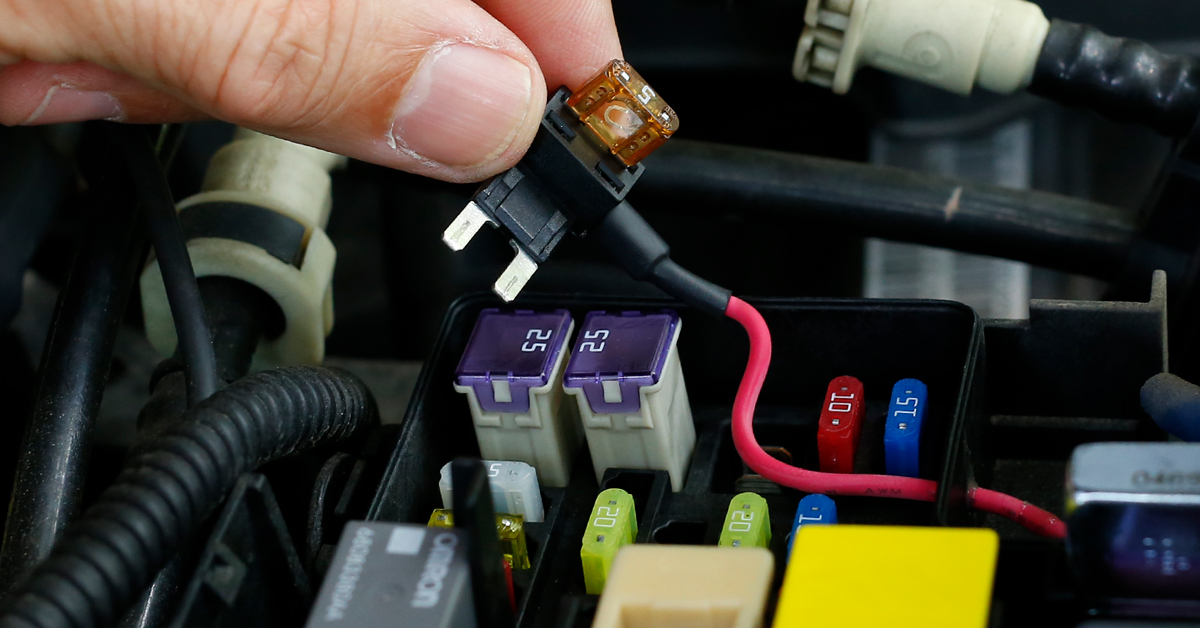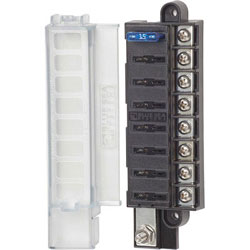The Definitive Guide to Blue Sea Fuse Block
Wiki Article
6 Simple Techniques For Blue Sea Fuse Block
Table of ContentsBlue Sea Fuse Block Things To Know Before You BuyThe Definitive Guide to Blue Sea Fuse BlockBlue Sea Fuse Block - An OverviewBlue Sea Fuse Block Fundamentals ExplainedThe Ultimate Guide To Blue Sea Fuse BlockNot known Incorrect Statements About Blue Sea Fuse Block
Fuses are bolted in position in between the bus bar and also the 2nd collection of electrically separated screws. With this installation you can connect the boat's numerous high-current circuits, such as a windlass, bow thruster, high-output generator, the DC panel, etc, to the isolated screws. The various merges are sized according to the current-carrying capability of the conductors bolted to them.Some circuits will still need to bypass the isolation button so that they may be left on when the remainder of the watercraft is closed down. blue sea fuse block. These circuits generally include a bilge pump and any billing devices (including photovoltaic panels, possibly a wind generator, and also the inverter if it likewise functions as a battery charger).
This is part of the circuit diagram we created for the facility example boat in our Watercraft Electrics training course. The tools connected to the fuse block in the upper right are all bypassing the seclusion button S1. If you enroll in Boat Electrics 101, you will learn how to review such a representation and also just how to make one for your very own boat.
The Greatest Guide To Blue Sea Fuse Block

With DC circuits, the OCP is always placed in the positive side of DC circuits. Note that some European boatbuilders set up merges as well as battery buttons in the DC adverse side and also on the favorable side, yet this is not advised other than in some separated (drifting) ground DC systems.
This factor might go to the battery, the battery switch, the distribution panel, a subsidiary panel, some distribution bus bar, or other connecting factor. If the conductors in the new circuit are no smaller than the conductor that feeds the brand-new circuit's factor of connection, after that the OCP for the feeder conductor will adequately secure the brand-new circuit - blue sea fuse block.
5 Easy Facts About Blue Sea Fuse Block Explained
Yet if the new circuit is not sufficiently offered by overcurrent tools already in position, additional security is needed at its point of link, i. e., at its resource of power. Placement of merges in the favorable conductor. Note exactly how a smaller sized fuse is utilized whenever a smaller sized conductor is connected, Occasionally area restricts how close an OCP tool can be placed to the source of power.If they should be installed in battery compartments, they need to be ignition shielded.) The question then arises, how close is close sufficient? The read what he said common solution, from the ABYC, is within 7" (17. 5cm). The ABYC allows the complying with, which have been tightened up recently: A conductor attached straight to a battery that is also "consisted of throughout its whole range in a sheath or enclosure such as an avenue, joint box, control box or encased panel" should have its overcurrent protection "as close as possible to the battery, yet not to surpass 72 inches (1 - blue sea fuse block.
Gone is the covering 72" allowance that made use of to be there. A conductor linked to a source of power various other than the battery (e. g., the battery button, the distribution panel, or some other point in the DC circuits) that is likewise consisted of in a sheath, and so on, must have its overcurrent protection "as close as practicable to the factor of connection to the resource of power, but not to go beyond 40 inches (1.
Blue Sea Fuse Block - An Overview
Provided that generators themselves are a resource of power, it has been open to question whether these included alternators needed OCP at the alternator itself."Cranking-motor circuits are not required to have overcurrent protection.In the marine field, where cranking circuits might be long, this technique might produce a threat. If a vehicle catches fire, the passengers can pull over and also jump out. If a watercraft ignites, it is not so basic. It makes no sense to have any kind of unguarded circuits on a watercraft.
In winter, the inrush current on a 12V starter motor might be as high as 1,500 amps; the cranking current may be as much as 200 amps. Often, cranking conductors are undersized even for the cranking current, not to mention the inrush existing. This situation does not position a safety issue in itself, because these currents are sustained for only a couple of secs, so the conductors do not have time to fume sufficient to develop a fire threat.
The Ultimate Guide To Blue Sea Fuse Block
If you intend to learn exactly how to wire a watercraft, detailed in 56 video clip lessons, take a look at our Boat Electrics 101 course. We made the course with absolute beginners in mind. As the electrical tons on watercrafts rises, so too does the intricacy of electrical circuits as well as the potential for brief circuits and electrical fires.
In the aquatic area, where cranking circuits may be long, this technique could create a Resources risk. It makes no feeling to have any kind of unsafe circuits on a boat.
Everything about Blue Sea Fuse Block

We made the course with absolute beginners in mind. As the electric tons on boats rises, so too does the complexity of electric circuits and also the potential for brief circuits and electrical fires.
Report this wiki page